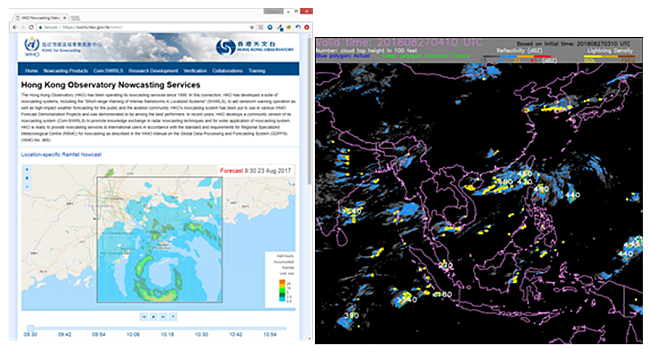A New Milestone in Weather
A New Milestone in Weather
WOO Wang-chun and WONG Wai-kin
September 2018
The Hong Kong Observatory was designated in June 2018 by the World Meteorological Organization (WMO) as the Regional Specialized Meteorological Centre (RSMC) for Nowcasting to provide support in nowcasting for meteorological services in the Asian region. On the Observatory’s dedicated website (https://rsmc.hko.gov.hk/), real-time products of location-specific rainfall, significant convection and ice crystal icing nowcasts for the next few hours are available (Figure 1) to enhance support in forecasting and alerting of severe weather and aviation meteorological services in the region.
"Nowcasting" refers to high-precision weather forecast for the next few hours. There are inherent uncertainties in the development of weather systems. In particular, the forecasting of the time and location of occurrence as well as the changes in movement and intensity of severe weather events are major challenges to the meteorology community. Heavy rain, thunderstorms, hail and gust can bring serious hazards within a very short time, thus requiring stringent forecast accuracy. To support rainstorm warning operation and to provide public nowcast services, the Observatory operates an in-house developed system called "SWIRLS - Short-range Warning of Intense Rainstorms in Localized Systems" that can quickly analyse the motion of radar echoes and rainfall distribution, and then extrapolate radar echoes to forecast the rainfall amount and the risk of severe weather at various locations.
The Observatory collaborates with the Civil Engineering and Development Department, the Drainage Services Department and the Water Supplies Department in rainfall nowcasting to reduce the risk of landslides and flooding, improve the ecological environment, preserve fresh water resources and enhance efficiency of drainage works. Over the past few years, the Observatory has developed one-hour lightning nowcast for the public, and provided lightning nowcast services for the Airport Authority and public utilities such as power company, cable car and theme park, etc. to meet their needs in operation and emergency response. In research and development for further improving forecast techniques, the Observatory and the Hong Kong University of Science and Technology jointly developed a rainfall nowcast algorithm based on deep learning methods in artificial intelligence (AI). In 2018, the Observatory partnered with Shenzhen Meteorological Bureau to organise an AI challenge and gathered experts in the field to develop novel nowcast techniques.
SWIRLS has supported numerous major international events, such as the Beijing Olympics Games, the Shanghai Expo, the Commonwealth Games in New Delhi, and the Universiade in Shenzhen. Built on these experience, the Observatory has developed a community version of SWIRLS (Com-SWIRLS) for sharing with other official meteorological agencies with an aim to building their capacity in weather nowcasting and provision of related warning services. To date, the meteorological services in the Mainland and overseas including Zhuhai, Hainan, the Philippines, Malaysia (Figure 2), India, Myanmar and South Africa have adopted Com-SWIRLS or engaged in active development of the applications of nowcasting products. The Observatory hosted workshops for the WMO, and organized the 4th International Symposium on Nowcasting and Very-short-range Forecast under the World Weather Research Programme in 2016, providing training on nowcasting technology and Com-SWIRLS to around a hundred meteorologists.
Looking ahead, the Observatory will continue the development of advanced weather nowcasting techniques as well as promotion of Com-SWIRLS and data sharing to foster advances in severe weather forecast and warning services. This does not only contribute towards the capacity building in meteorology in the region, but also enables members of the public to be better prepared for potential natural disasters.

Figure 1:Website of RSMC for Nowcasting showing location-specific rainfall and significant convection forecasts

Figure 2:Application of Com-SWIRLS in Malaysia